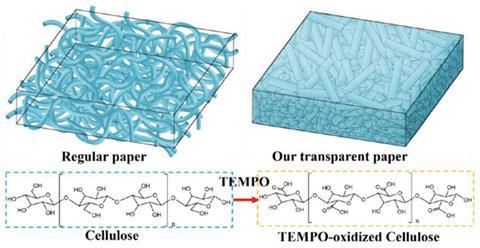
High transparency and high optical haze are two desirable properties for efficient solar cells. The greater the transparency the more light can reach the device. The greater the haze the more light is scattered and trapped in the cell. However, there is usually a trade-off between the two. For example, tracing paper has a high optical haze of over 50% but a transparency of less than 80%. Conversely, plastic has a high transparency of about 90% but an optical haze of less than 1%.
Now, researchers have designed a transparent paper that has both high optical transparency (96%) and high haze (60%), and demonstrated its effectiveness as a solar cell substrate. 'We can get a substrate with a high optical transmittance and, meanwhile, high optical scattering in the forward direction,’ say Liangbing Hu, a co-author of the research at the University of Maryland. ‘No other transparent substrates have such properties that are ideal for solar cells.’
The paper was made by unzipping primary cellulose fibres. The team did this by processing micro-sized wood fibres using a TEMPO NaBr-NaClO oxidation system to introduce carboxyl groups into the cellulose. This weakens hydrogen bonding between the cellulose fibrils and causes the wood fibres to swell up and collapse. The result is high packing density and excellent optical properties.

The team laminated the paper onto an organic solar cell to test it, and saw the power conversion efficiency increase from 5.34% to 5.88%. 'Our transparent paper can increase the energy efficiency of any type of solar cell where light trapping is helpful,' says Hu. 'This will enable low-cost solar cells based on wood nano structures.'
'This is the best example I've seen of integrating a simple scattering medium as a photon concentrator,' comments Anthony Harriman, who designs artificial photsynthetic systems at Newcastle University, UK. 'The diffusive nature of the paper is most impressive and could lead to important advances in designing simple optical circuits without elaborate tracking devices.'






No comments yet